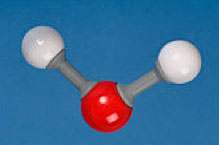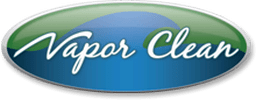Water: Nature's Solvent
when super heated, becomes dry steam vapor
The chemistry of steam cleaning
What if there were a single chemical capable of cleaning a surface safely, is remarkably inexpensive and outrageously effective? What if the chemical was so effective at cleaning you already trust it to clean your own body everyday? What if it is so inexpensive that nearly every home in America has it on tap? And what if it was so safe that you would think nothing of drinking a glass of it?
That chemical is the most basic and fundamental of all chemical compounds. Yep, it is plain water.

Water Molecule
Miraculous Water
How, you may ask, is it possible to transform basic water into such a powerful cleaning agent? A more interesting question is how does water do ANY of the miraculous things it does? Water is necessary for creating and sustaining all of life! Cleaning up a little spilled coffee should hardly pose a challenge!
Chemical Revolution
Alas, there is an entire industry that is offering variations on this trusty friend. Today, the chemical cleaning industry is a collection of super-corporations beginning in the early 1900's; enjoying its rise to fame in the time following World War II. For the most part, the idea of blending chemical additives with water to clean was a response to large industrial equipment that was too difficult, time-consuming, or costly to clean any other way. The introduction of chemical components in water to "scrub" and "sweep" away dirt and grime became extremely popular considering the job was done adequately and comparatively inexpensively. Unfortunately, safety was not high on the list and these untested chemical concoctions proved to be hazardous, usually to the people handling them and almost always to the environment.
What about Eco-Friendly and "Green cleaners?"
Through science and years of consumer pressure, chemical companies have developed "safer" formulations. Past formulas have been reviewed and found to be unsafe or not as safe as claimed. The question is, "Is all of this really necessary?" You may wonder, "What benefit am I really gaining from all the chemicals" and "Are they harming my family?" Is there a better way?
Let the facts speak!
The answer is, yes. The better way happens to be as simple as...well...water. You see, after all the fussing with the formulas, water is still the basis for all the chemicals you buy today. If concentrated (water removed), water is the base you mix your chemical into before use. When finished with the chemical, water is the cleaner you use to rinse off the "cleaner." Water is perfect for the job! Now, enter the steam cleaner..
So if water is the answer, why do people trust chemicals? The answer has two parts: First, no one is marketing water! Chemical companies spend hundreds of millions of dollars every year marketing their products. Sure, most chemicals work at removing dirt. But so does water!
Second, water has to be transformed into steam vapor. Everyday, millions of Americans transform water to suit a particular purpose. Frozen water serves as ice in a beverage or as First Aid to a bump. Hot water serves as a relaxing bath or a cooking agent for a pot of pasta. In fact, steam serves as a cleaner in dishwashers and for fine clothing!
Vapor is just one more transition for this perfect compound. A Vapor Clean machine is the way to tackle a variety of cleaning challenges all around your home or place of work. The combination of temperature and pressure allows the Vapor Clean steam cleaner to make light work of nearly impossible cleaning tasks. Fast, thorough, safe and as inexpensive as water. This is how cleaning gets done chemical-free.
Cut out the Chemicals!
With the ever increasing use of chemicals and illnesses related to the oversupply and use in our society - now more than ever can we reap the health benefits of steam cleaning while making our home purely clean and leaving nothing behind to contaminate our space.
Did you know...........
Within 26 seconds after exposure to chemicals, they can be found in every organ in the body.
The Clean Water Fund estimates that the average American uses 40 lbs of unsafe household cleaners each year (multiply that by 245 million Americans)
Children are more susceptible to toxins than adults. Kids receive proportionately larger doses of environmental toxins than adults
Check out your household cleaner's ingredients and safety ratings on the link below
http://hpd.nlm.nih.gov/cgi-bin/household/list?tbl=TblBrands&alpha=A
Brain Food
The Chemical Registry System (CRS), which is the US EPA's central system for tracking regulated chemicals, lists over 71,000 chemicals. Most of those have not been properly tested for human and environmental effects.
Autism: Thinking the Unthinkable
To cling to a purely genetic explanation of autism is a desperate attempt to maintain the illusion that one lives in a comfortable and rational world where new chemicals and technologies always mean progress, experts are always objective and thorough, corporations are honest, and authorities can be trusted. That human actions rather than genetics, might be responsible for compromising the health of a significant proportion of a whole generation is so painful as to be, for many, unthinkable.
Martha Herbert, MD PhD
Harvard School of Medicine
Sources of Indoor Air Pollution - Organic Gases (Volatile Organic Compounds - VOCs)
EPA's Total Exposure Assessment Methodology (TEAM) studies found levels of about a dozen common organic pollutants to be 2 to 5 times higher inside homes than outside.
......while people are using products containing organic chemicals, they can expose themselves and others to very high pollutant levels, and elevated concentrations can persist in the air long after the activity is completed.
Organic chemicals are widely used as ingredients in household products.
Get back to basics
Reduce Allergies -Create a Healthier Environment -
Reduce residues & toxins from your home simply with steam cleaning
Nearly 5 million children have asthma (6.9% of children under 18)
What Makes Asthma Worse?
Allergens, Warm-blooded pets (including dogs, cats, birds, and small rodents), House dust mites, Pollens from grass and trees, Molds (indoors and outdoors). Irritants, Cigarette smoke and wood smoke. Scented products such as hair spray, cosmetics, and cleaning products. Strong odors from fresh paint or cooking. Automobile fumes and air pollution. Chemicals such as pesticides and lawn treatments
"It's not how much we do... but how much love we put into doing it!"
|
Even if you store chemical cleaners in secure cupboards, above the reach of children, simply using them may do harm. Many of them release toxic or irritating volatile organic compounds (VOCs) into the air. "My eight-month-old baby™s eyes tear up every time I clean my house; I have to do it when she™s not there," says Maritza Rios of New York City. While adults may not react to cleaning products, their fumes may affect infants and children because they haven™t fully developed the ability to remove toxins from their bodies. Other common cleaners can be more harmful. Corrosive or caustic cleaners, such as lye and acids “ found in drain cleaners, oven cleaners and acid-based toilet bowl cleaners “ are the most dangerous cleaning products because they burn skin, eyes and internal tissue easily, according to Phillip Dickey, director of Washington Toxics Coalition (WTC). |
What Causes Asthma?Asthma is a complex disease with multiple causes. Asthma attacks are triggered by a series of factors, typically acting in concert with one another. Asthma has been called "a classic example of a disease caused by gene-environment interaction". Certain insecticides that are widely used in U.S. homes may be triggers for asthma. Studies indicate that exposure to organophosphate pesticides disrupts the part of the nervous system that regulates the motor functioning of the lungs. This has lead researchers to hypothesize that pesticides are among the preventable causes of asthma in children. |
PERC - A STAIN ON THE DRY CLEANING INDUSTRY
New Types of Dry Cleaning That Are Better for the Environment and Safer for You
There are over 30,000 dry cleaning facilities for you to choose from in the United States, but 95 percent of them use the toxic chemical perchloroethylene (perc) as the primary cleaning solvent. Exposure to perc is a significant risk to the workers who dry clean the clothes, and it's also a health risk to you and the loved ones who share your home. Once you get the dry-cleaned clothes home, they continue to off-gas perc into the air in your abode.
The National Institute of Environmental Health Sciences states that: "Short-term exposure to PERC can cause adverse health effects on the nervous system that include dizziness, fatigue, headaches, sweating, incoordination, and unconsciousness. Long-term exposure can cause liver and kidney damage." The International Association for Research on Cancer classifies perc as a probable carcinogen.
Fortunately, there are healthier (and greener) dry-cleaning alternatives. Here they are:
* Wet Cleaning ” This is a system that uses biodegradable soap and water. Computer-controlled dryers and stretching machines ensure that the fabric retains its natural size and shape. Wet cleaning can purportedly clean 99.9% of "dry clean only" garments safely, including leather; suede; most tailored woolens, silks and rayons. (Neckties seem to be the one exception.)
Your home can truly become your sanctuary - with so many outside variables in our work and outside environment, steam vapor cleaners can make a difference for you and your family.
Look at what dry steam can do for you
Microbiological Laboratory Test Results using Dry Vapor Steam Cleaner Desiderio / VS 3000
Unit Tested at 72.5 PSI Gres
| Type Of Material: Teflon |
Colonies Per Square Centimeter | Colonies Per Square Centimeter |
| Surface Contamination Type | Before Treatment | After Treatment |
| Saccharomyses Cerevisiae | 129 | 0 |
| Pseudomonas Aeruginosa | 125 | 0 |
| E. Coli | 103 | 0 |
| Bacillus Cereus | 112 | 2 |
| Staphylococcus Aureus | 100 | 0 |
| Streptococcus Faecalis | 125 | 0 |
| Type Of Material: Stainless Steel | Colonies Per Square Centimeter | Colonies Per Square Centimeter |
| Surface Contamination Type | Before Treatment | After Treatment |
| Saccharomyses Cerevisiae | 92 | 0 |
| Pseudomonas Aeruginosa | 105 | 0 |
| E. Coli | 138 | 0 |
| Bacillus Cereus | 95 | 0 |
| Staphylococcus Aureus | 100 | 0 |
| Streptococcus Faecalis | 97 | 0 |
| Type Of Material: Porcelain |
Colonies Per Square Centimeter | Colonies Per Square Centimeter |
| Saccharomyses Cerevisiae | 98 | 0 |
| Pseudomonas Aeruginosa | 112 | 2 |
| E. Coli | 115 | 0 |
| Bacillus Cereus | 70 | 1 |
| Staphylococcus Aureus | 88 | 0 |
| Streptococcus Faecalis | 77 | 0 |
